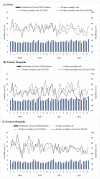Public Reporting on the Quality of Care in Patients with Acute Myocardial Infarction: The Korean Experience
- PMID: 35328856
- PMCID: PMC8955521
- DOI: 10.3390/ijerph19063169
Public Reporting on the Quality of Care in Patients with Acute Myocardial Infarction: The Korean Experience
Abstract
Public reporting is a way to promote quality of healthcare. However, evidence supporting improved quality of care using public reporting in patients with acute myocardial infarction (AMI) is disputed. This study aims to describe the impact of public reporting of AMI care on hospital quality improvement in Korea. Patients with AMI admitted to the emergency room with ICD-10 codes of I21.0 to I21.9 as the primary or secondary diagnosis were identified from the national health insurance claims data (2007-2012). Between 2007 and 2012, 43,240/83,378 (51.9%) patients manifested ST segment elevation myocardial infarction (STEMI). Timely reperfusion rate increased (β = 2.78, p = 0.001). The mortality rate of STEMI patients was not changed (β = -0.0098, p = 0.384) but that of NSTEMI patients decreased (β = -0.465, p = 0.001). Public reporting has a substantial impact on the process indicators of AMI in Korea because of the increased reperfusion rate. However, the outcome indicators such as mortality did not significantly change, suggesting that public reporting did not necessarily improve the quality of care.
Keywords: NSTEMI; ST segment elevation myocardial infarction; acute myocardial infarction; mortality; public reporting; quality of care.
Conflict of interest statement
The authors declare no conflict of interest. The funders had no role in the design of the study; in the collection, analyses, or interpretation of data; in the writing of the manuscript, or in the decision to publish the results.
Figures


Similar articles
-
In-hospital outcomes and 5-year mortality following an acute myocardial infarction in patients with a history of cancer: Results from the French registry on Acute ST-elevation or non-ST-elevation myocardial infarction (FAST-MI) 2005 cohort.Arch Cardiovasc Dis. 2019 Nov;112(11):657-669. doi: 10.1016/j.acvd.2019.06.012. Epub 2019 Nov 21. Arch Cardiovasc Dis. 2019. PMID: 31761740
-
[Long-term survival of patients with acute myocardial infarction in Iceland].Laeknabladid. 2018 Nov;104(11):491-497. doi: 10.17992/lbl.2018.11.203. Laeknabladid. 2018. PMID: 30375980 Icelandic.
-
Acute Myocardial Infarction: Changes in Patient Characteristics, Management, and 6-Month Outcomes Over a Period of 20 Years in the FAST-MI Program (French Registry of Acute ST-Elevation or Non-ST-Elevation Myocardial Infarction) 1995 to 2015.Circulation. 2017 Nov 14;136(20):1908-1919. doi: 10.1161/CIRCULATIONAHA.117.030798. Epub 2017 Aug 27. Circulation. 2017. PMID: 28844989
-
Prehospital diagnosis of patients with acute myocardial infarction.Diagnosis (Berl). 2016 Dec 1;3(4):155-166. doi: 10.1515/dx-2016-0021. Diagnosis (Berl). 2016. PMID: 29536903 Review.
-
Contemporary NSTEMI management: the role of the hospitalist.Hosp Pract (1995). 2020 Feb;48(1):1-11. doi: 10.1080/21548331.2020.1701329. Epub 2020 Feb 20. Hosp Pract (1995). 2020. PMID: 31815570 Review.
References
-
- Korean Staticstical Information Service Number of Deaths by Cause. [(accessed on 15 July 2018)];2014 Available online: http://kostat.go.kr/portal/eng/pressReleases/1/index.board?bmode=read&bS....
-
- OECD Health Statistics. OECD Health Statistics 2017. [(accessed on 15 July 2018)]. Available online: - DOI
-
- Hunt S.A. ACC/AHA 2005 Guideline Update for the Diagnosis and Management of Chronic Heart Failure in the Adult: A Report of the American College of Cardiology/American Heart Association Task Force on Practice Guidelines (Writing Committee to Update the 2001 Guidelines for the Evaluation and Management of Heart Failure) J. Am. Coll. Cardio. 2005;46:e1–e82. - PubMed
-
- Centers for Medicare and Medicaid Services Hospital Compare—Centers for Medicare & Medicaid Services. Centers for Medicare and Medicaid Services. [(accessed on 2 April 2019)]; Available online: https://www.cms.gov/medicare/quality-initiatives-patient-assessment-inst....
Publication types
MeSH terms
LinkOut - more resources
Full Text Sources
Medical

